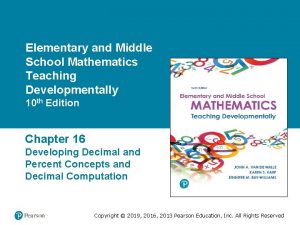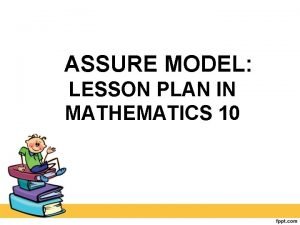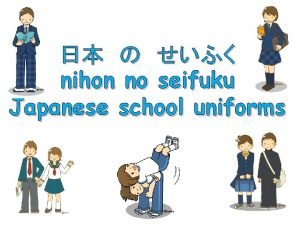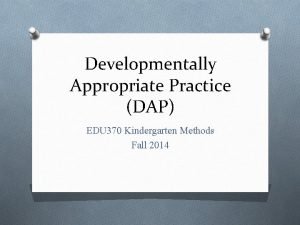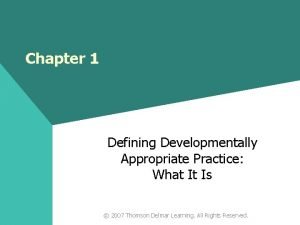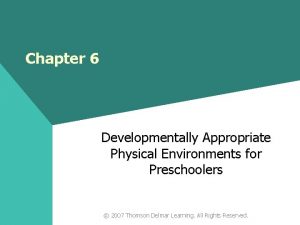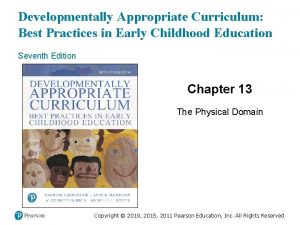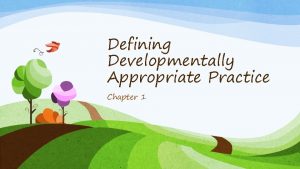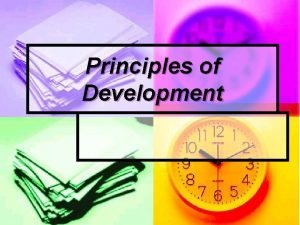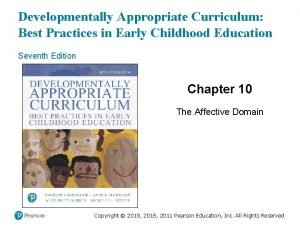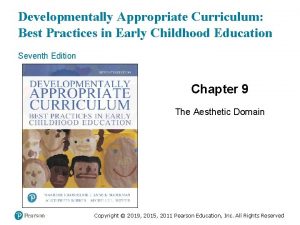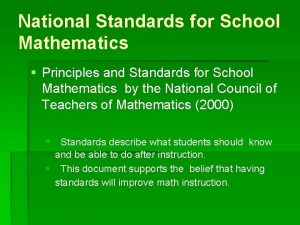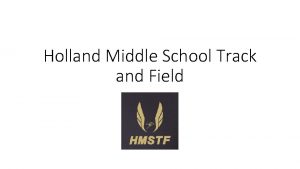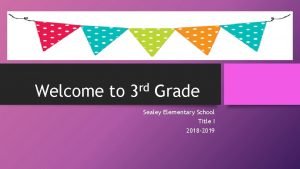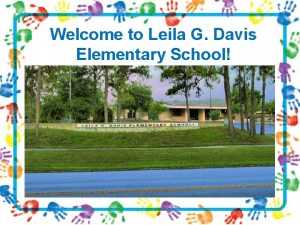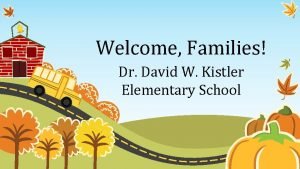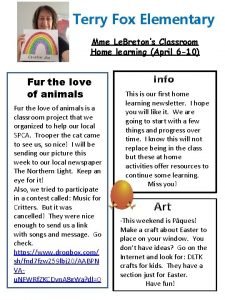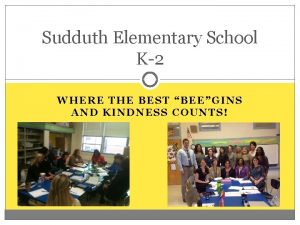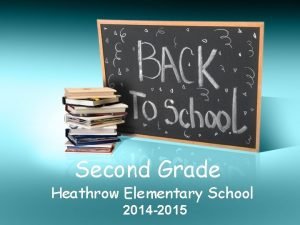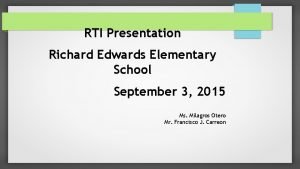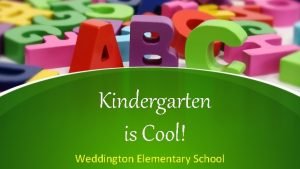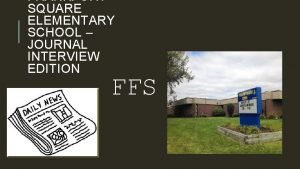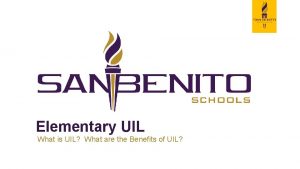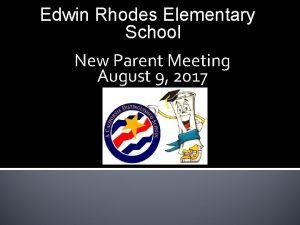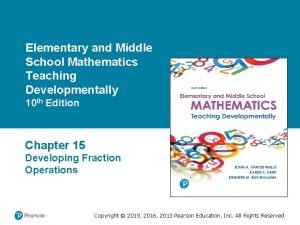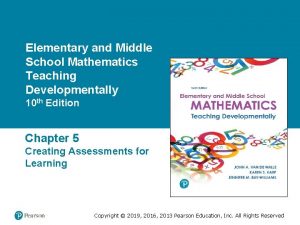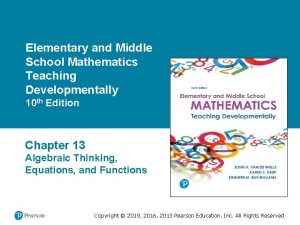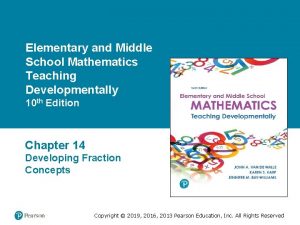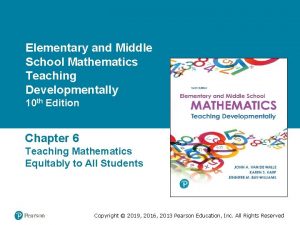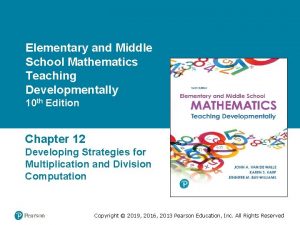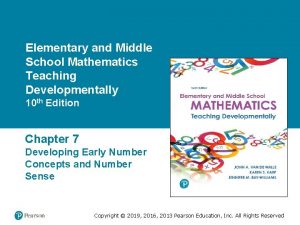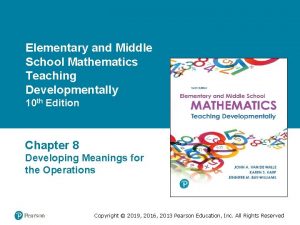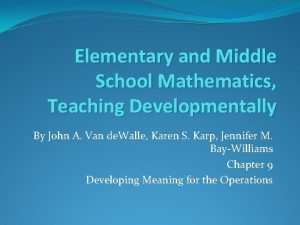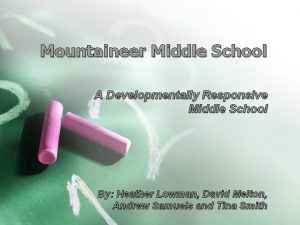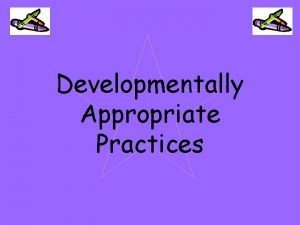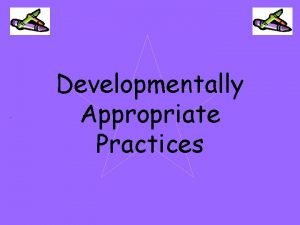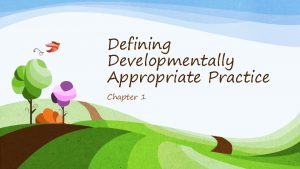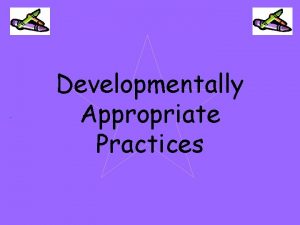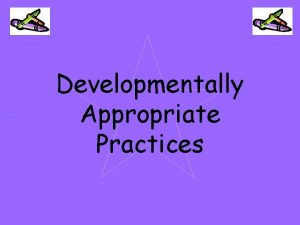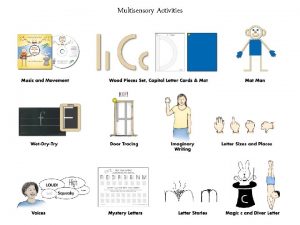Elementary and Middle School Mathematics Teaching Developmentally 10


































- Slides: 34

Elementary and Middle School Mathematics Teaching Developmentally 10 th Edition Chapter 18 Developing Measurement Concepts Copyright © 2019, 2016, 2013 Pearson Education, Inc. All Rights Reserved

Learner Outcomes 18. 1 Describe the measurement process, including the identification and use of nonstandard and standard units, and demonstrate how to estimate measurements. 18. 2 Demonstrate how to measure the length of objects. 18. 3 Explain the development of area formulas. 18. 4 Explain how volume is measured. 18. 5 Demonstrategies for comparing weights of objects. 18. 6 Explain how angles are measured. 18. 7 Describe the best model for teaching elapsed time. 18. 8 Explain strategies for counting a collection of coins. Copyright © 2019, 2016, 2013 Pearson Education, Inc. All Rights Reserved

Standards-Based Development (1 of 2) Measurement appears in every grade level from K-8. Here are some key concepts for length: • Pre. K and kindergarten level, students begin with direct comparisons of two or more lengths and then move to indirect comparisons by Grade 1 • Grade 2 It is useful to measure the same object with units of different size to help students understand that the unit used is important. Students in the second grade begin to consider the relationship between the size of a unit and the resulting measure. • Grade 3 students should wrestle with partial units and mentally put together two or more partial units to count as one unit which prepares them for the use of fractional units in fifth grade. • 4 th and 5 th graders must be able to convert measures in the same system to larger or smaller units. Copyright © 2019, 2016, 2013 Pearson Education, Inc. All Rights Reserved

Standards-Based Development (2 of 2) Here are some key concepts for Area: Estimating and measuring area begins in Grade 3, as students connect to multiplication using arrays, and continues in Grade 4 with finding the area of rectangles using formulas. In Grade 5 students explore area problems with fractional measures and use area to find volumes of three-dimensional shapes. By Grade 6, students explore area of a wide range of polygons and learn surface area. In Grade 7, students explore area of circles. Here are some key concepts for Volume and Capacity: • Volume and capacity are terms for measures of the “size” of threedimensional regions—a topic beginning in the fifth grade with rectangular prisms, with continuing emphasis in grades 6 and 8 with cylinders, cones, and spheres. • Understanding the formula for volumes of these shapes is expected in eighth grade. Copyright © 2019, 2016, 2013 Pearson Education, Inc. All Rights Reserved

The Meaning and Process of Measuring Measurement is: A number that indicates a comparison between the attribute of the object being measured and the same attribute of a given unit of measure. Measurement means that the attribute being measured is filled, covered, or matched with a unit of measure with the same attribute. Copyright © 2019, 2016, 2013 Pearson Education, Inc. All Rights Reserved

Measurement Instruction: A Sequence of Experiences Step Goal Type of Activity Notes 1. Make comparisons Students will understand the attribute to be measured. Make comparisons based on the attribute (for example, longer/shorter, heavier/lighter). Use direct comparisons whenever possible. When the attribute is understood, there is no further need for comparison activities. 2. Use models of measuring units Students will understand how filling, covering, matching, or making other comparisons of an attribute with measuring units produces a number called a measure. Use physical models of measuring units to fill, cover, match, or make the desired comparison of the attribute with the unit. Begin with nonstandard units, then progress to the use of standard units. Measuring tools and formulas follow. 3. Use measuring tools Students will use common measuring tools with understanding and flexibility. Make measuring tools (grouped units) and compare them with the individual unit models to see how the measurement tool performs the same function. Without a careful comparison of the nonstandard (or informal) tools with the standard tools, the connection can be lost. Copyright © 2019, 2016, 2013 Pearson Education, Inc. All Rights Reserved

Why Use Nonstandard Units? 1. Focus directly on the attribute being measured - irregular shapes can be measured with square tiles or circle counters. 2. Avoids conflicting objectives in introductory lessons - lessons on what it means to measure area. 3. Provide a rationale for using standard units. Standard units have more meaning after students have experienced measuring with their own collection of nonstandard units. Examples of nonstandard for length - Giant footsteps, measuring ropes. Drinking straws, connecting cubes and paper clips. Copyright © 2019, 2016, 2013 Pearson Education, Inc. All Rights Reserved

Recording Measurements with Nonstandard Standard Units to Find Length Questions to ask: How did you get your measurement? Did students who measured with the same unit get the same answers? Focus on the value of lining units up end to end. Discuss what happens if you overlap units, have a gap in units or don’t follow a straight line. Copyright © 2019, 2016, 2013 Pearson Education, Inc. All Rights Reserved

Introducing Standard Units Three broad goals: 1. Familiarity with the unit 2. Ability to select an appropriate unit 3. Knowledge of the relationship between units Develop familiarity with standard units: • Comparisons that focus on a single unit • Activities that develop personal referents or benchmarks for single units or easy multiples of units Copyright © 2019, 2016, 2013 Pearson Education, Inc. All Rights Reserved

Activity 18. 3 Personal Benchmarks Familiarity with the Unit Materials - Measure and compare your body Directions: Measure about how long are your: Compare the distance around your waist to your neck and wrist. Compare your height to the height of your head. Graph data and explore- • Foot Which measures are similar, about double? • Stride • Hand Span • Width of your finger Can you find a personal benchmark, 1 c m ? 10 c m ? enti eter Copyright © 2019, 2016, 2013 Pearson Education, Inc. All Rights Reserved

Ability to Select an Appropriate Unit Should the room be measured in inches or feet? Should the concrete blocks be weighed in grams or kilograms? To cut a piece of molding, do I measure to the nearest inch? To determine how many 8 foot pieces of molding to buy do I measure to the nearest foot? Knowing the size of the unit and the level of precision are important to meet this goal. Copyright © 2019, 2016, 2013 Pearson Education, Inc. All Rights Reserved

Knowledge of the Relationship Between Units Relationships between Instructionally – Begin with customary or metric units common items and use those are conventions. measures as references and benchmarks. Therefore, students must be told and then have Doorway – 2 meters experiences to reinforce Doorknob – 1 meter from floor the conventions. Paper clip – about 1 gram Avoid mechanical rules and create conceptual, Pineapple or liter of water – 1 meaningful methods for kilogram conversion. Copyright © 2019, 2016, 2013 Pearson Education, Inc. All Rights Reserved

Role of Estimation and Approximation Measurement estimation is process of using mental and visual information to measure without using measurement instruments. 1. Focus on the attribute being measured and the measuring process 2. Provides and intrinsic motivation for measurement activities. 3. Helps develop familiarity with units. 4. Promotes multiplicative reasoning through using a benchmarks. Copyright © 2019, 2016, 2013 Pearson Education, Inc. All Rights Reserved

Strategies for Estimating Measurement Where in this picture do you see a) Benchmarks or referents? b) Chunking or using sub dividing? c) Iterate units? Copyright © 2019, 2016, 2013 Pearson Education, Inc. All Rights Reserved

Activity 18. 5 Estimation Exploration Materials - An object like a box, pumpkin, a painting on the wall, or a person Directions - Each day, select a different attribute or dimension to estimate. Ask students to estimate attributes like height, circumference, weight, volume, and surface area. Copyright © 2019, 2016, 2013 Pearson Education, Inc. All Rights Reserved

Physical Models and Length Units Four important principles of iterating units of length, standard or nonstandard: 1. Units must be in equal length or you cannot iterate them by counting. 2. Units must align with the length being measured, or a different quantity is measured. 3. Units must be placed without gaps, or a part of the length is not measured. 4. Units must be placed without overlaps, or the length has portions that are measured more than one time. Copyright © 2019, 2016, 2013 Pearson Education, Inc. All Rights Reserved

Area- A Measure of Two-Dimensional Space Inside a Region Using units of area Comparison activities help students distinguish between size and shape, length and other dimensions. Copyright © 2019, 2016, 2013 Pearson Education, Inc. All Rights Reserved

Activity 18. 16 Tangram Areas Materials: Outlines of Tangram Shapes and a set of Tangram pieces Directions - Ask students to estimate what shape has the largest (or smallest) area. Students will use tangrams to identify which shapes are same size, which are larger, and which are smaller. Ask students to justify their conclusions. Copyright © 2019, 2016, 2013 Pearson Education, Inc. All Rights Reserved

Using Physical Models of Area Units (1 of 2) Students need multiple opportunities to “cover the surface” of two-dimensional shapes to develop the understanding of the attribute of area. • Index cards • Square tiles • Cuisenaire rods • Sticky notes Encourage students to wrestle with partial units. Copyright © 2019, 2016, 2013 Pearson Education, Inc. All Rights Reserved

Using Physical Models of Area Units (2 of 2) Goal- apply student’s developing concepts of multiplication to the area of rectangles. First row thought of as a single unit that is replicated to fill the rectangle. Grids are the “area rulers”. It lays out the units for you. Copyright © 2019, 2016, 2013 Pearson Education, Inc. All Rights Reserved

Activity 18. 19 What’s the Rim Relationship Between Area and Perimeter is a length measure of the distance around a region. Perimeter- Good hint “rim” Materials- Identify objects to measure. Tools - Rulers, cash register tape, non-stretching string Measure the perimeter and record, noting the unit. Describe how you measured objects larger than the tool. Discuss - Methods used to measure the objects Comparison of common items measured How they determined what measurement tool to use? Copyright © 2019, 2016, 2013 Pearson Education, Inc. All Rights Reserved

Developing Formulas for Perimeter and Area Overemphasis on formulas with little or no conceptual background results in misconceptions. Difficulty in conceptualizing the meaning of height and base Confusing linear and square units Heights of two-dimensional figures are not always measured along an edge. Perimeter - only consider two numbers Copyright © 2019, 2016, 2013 Pearson Education, Inc. All Rights Reserved

Areas- Rectangles, Parallelograms, Triangles and Trapezoids Transform a parallelogram into a rectangle Transform a triangle into a parallelogram Transform a trapezoid into a parallelogram Copyright © 2019, 2016, 2013 Pearson Education, Inc. All Rights Reserved

Circumference and Area of Circles Circumference - Distance around or perimeter Diameter - A line segment through the center joining two points on the circle Development of the formula: • Cover a circle with tiles • Use radius squares • Cut to make a parallelogram Copyright © 2019, 2016, 2013 Pearson Education, Inc. All Rights Reserved

Volume and Capacity Measures of the “size” of three-dimensional figures and or the capacity of a container • Comparison activities: – Fill a container with a liquid, and pour that amount into a comparison container. – Capacity Sort – Sort collections of containers into “holds more, less or same” around a target container. – Fixed Volume: Comparing Prisms – Students build rectangular prisms with centimeter cubes to compare surface area. Tools for measuring volume - Solid units and containers Copyright © 2019, 2016, 2013 Pearson Education, Inc. All Rights Reserved

Developing Formulas for Volume and Common Shapes Models, precise language and illustrations will guide the development and understanding of the formulas. Copyright © 2019, 2016, 2013 Pearson Education, Inc. All Rights Reserved

Weight- Measure of the Pull or Force of Gravity on an Object Mass- the Amount of Matter in an Object and a Measure of the Force Needed to Accelerate It Comparison activities: • Hold an object in each hand, and feel the pull • Pan balance (Mass) or Spring scale (Weight) Units of weight or mass: • Nonstandard large paper clips, wooden blocks, metal washers, coins • Standard gram or ounce weights Copyright © 2019, 2016, 2013 Pearson Education, Inc. All Rights Reserved

Using Physical Models of Angular Measure Units Comparison activities • Trace one angle and place the other angle over it to compare (use angles with varied ray lengths) • Use a smaller angle (A Unit Angle) to measure a larger angle Copyright © 2019, 2016, 2013 Pearson Education, Inc. All Rights Reserved

Time- Duration of an Event from Beginning to End Clock reading—suggested approach 1. Begin with one-handed clock. Use approximate language - “It’s about 7 o’clock”. Relate the time after the hour to the time before the next hour. 1. 2. 3. 4. 5. 6. Discuss what happens to the big hand as the little hand goes from one hour to the next. Use two clocks, one with an hour hand only and one with two hands. Teach time in 5 -minute intervals - Point to 4, and say “it’s about 20 minutes after the hour”. Predict the reading on a digital clock when shown an analog and vice versa. Relate time after the hours to the time before the next hour. Discuss the issue of A. M. and P. M. Copyright © 2019, 2016, 2013 Pearson Education, Inc. All Rights Reserved

Elapsed Time: Solving a Problem Involving Conversion of One Measure of Time to Another Solving problems involving addition and subtraction of time intervals. Empty number line is a computational model. Copyright © 2019, 2016, 2013 Pearson Education, Inc. All Rights Reserved

Money ideas and skills required in primary grades • Recognizing coins • Identifying and using values of coins • Counting and comparing sets of coins • Creating equivalent coin collections • Selecting coins for a given amount • Making change • Solving word problems involving money Copyright © 2019, 2016, 2013 Pearson Education, Inc. All Rights Reserved

Common Errors or Misconceptions in Measurement (1 of 3) Common Error or Misconception What It Looks Like How to Help Focus on the ending point of a ruler rather than the length. Without attending to where an object is aligned on the left side of a ruler, students read the number on the ruler that aligns with the object’s right edge. A car is next to a ruler, spanning from 2 to 7 units. How to help is as follows. Move items along a ruler and ask students if they believe the item has changed size. Students have gaps between units or use unequal units when measuring length: A pencil is measured with rectangular tiles with gaps between them, and 1 tile that is a d Students overlap units when measuring area: Square tiles are in 2 rows of 6, many tiles are overlapped instead of side by side. Ask students to estimate the measure before measuring the object and explain why it is a reasonable estimate. Place multiple individual units with gaps between the units or with some of the units overlapping; or students use unequal units. Iterate units to show long the item is and then show those units match the units on the ruler. Give students experiences with the Broken Ruler. If students use unequal units, ask what the number refers to (e. g. , the number of white rods or brown rods). If students overlap length units, have them use linking cubes to measure length. If students overlap area units use a unit with some thickness making it difficult to overlap the pieces (e. g. , plastic square tiles or pattern blocks). Copyright © 2019, 2016, 2013 Pearson Education, Inc. All Rights Reserved

Common Errors or Misconceptions in Measurement (2 of 3) Count tick marks rather than units. Bigger units result in a larger measure. Measure perimeter by counting two sides. Measure perimeter by counting square units rather than side lengths. If you know the area of the figure you know the perimeter and vice versa. Cutting shapes into parts and rearranging the places changes the area. Area formula can be stated but they cannot describe what area is in words. Copyright © 2019, 2016, 2013 Pearson Education, Inc. All Rights Reserved

Common Errors or Misconceptions in Measurement (3 of 3) As the side of the length of the figure doubles, the area doubles. Use L × W for the area of other figures than rectangles. Estimates of measures must be “exact” and will be graded on how close you are to the “right” answer. The larger the rays of the angle, the larger the angle. The height of the solid figure or container indicates the volume. The length of the size of an object is an indication of its weight. Confusion about the minute and hour hands on an analog clock, or students read the number closest to the hour as the hour. The size of coin correlates to its value. Copyright © 2019, 2016, 2013 Pearson Education, Inc. All Rights Reserved
 Elementary and middle school mathematics 10th edition
Elementary and middle school mathematics 10th edition Clever dpscd login
Clever dpscd login Assure lesson plan sample
Assure lesson plan sample Japanese pe uniforms
Japanese pe uniforms Utilitarian aims of teaching mathematics
Utilitarian aims of teaching mathematics Approach in teaching
Approach in teaching Microteaching is a scaled down teaching
Microteaching is a scaled down teaching 10 effective dap teaching strategies
10 effective dap teaching strategies Define developmentally appropriate practice
Define developmentally appropriate practice Developmentally appropriate environment
Developmentally appropriate environment Developmentally appropriate curriculum 7th edition
Developmentally appropriate curriculum 7th edition Define developmentally appropriate practice
Define developmentally appropriate practice Development occurs in a relatively orderly sequence
Development occurs in a relatively orderly sequence An appropriate developmental curriculum
An appropriate developmental curriculum Developmentally appropriate curriculum 7th edition
Developmentally appropriate curriculum 7th edition Principles and standards for school mathematics
Principles and standards for school mathematics Holland middle school track and field
Holland middle school track and field Ubujan elementary school
Ubujan elementary school William beanes elementary school
William beanes elementary school Mackay elementary school tenafly
Mackay elementary school tenafly Sealey elementary school
Sealey elementary school Leila davis elementary school
Leila davis elementary school Wexford elementary school
Wexford elementary school Kistler elementary school
Kistler elementary school Pta membership drive ideas
Pta membership drive ideas Terry fox elementary school
Terry fox elementary school Sudduth elementary school
Sudduth elementary school Heathrow elementary school
Heathrow elementary school Richard edwards elementary school
Richard edwards elementary school Lydiksen elementary
Lydiksen elementary Hollifield station elementary school
Hollifield station elementary school Ucps cata
Ucps cata Frankfort square elementary school
Frankfort square elementary school What is uil
What is uil Edwin rhodes elementary school lunch menu
Edwin rhodes elementary school lunch menu
